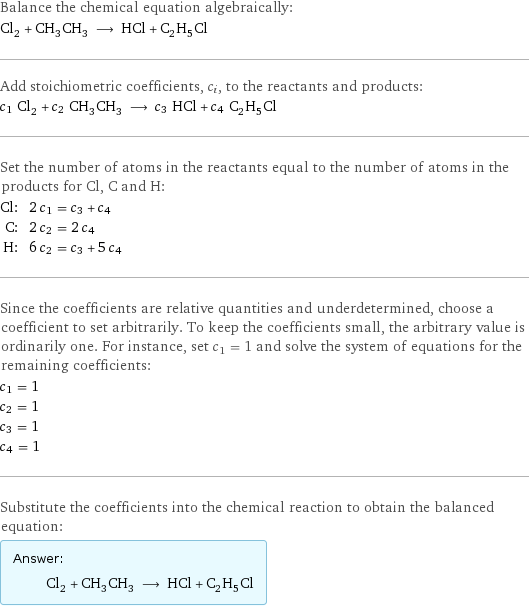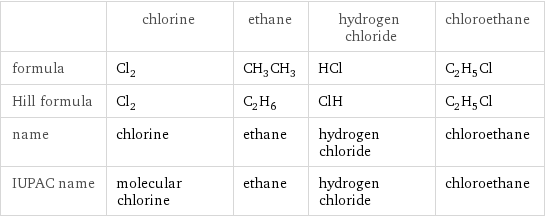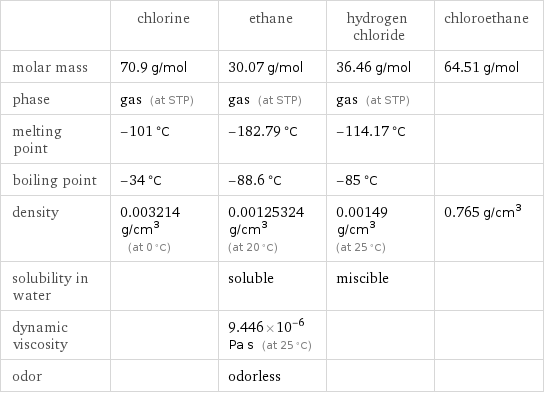Input interpretation

Cl_2 chlorine + CH_3CH_3 ethane ⟶ HCl hydrogen chloride + C_2H_5Cl chloroethane
Balanced equation

Balance the chemical equation algebraically: Cl_2 + CH_3CH_3 ⟶ HCl + C_2H_5Cl Add stoichiometric coefficients, c_i, to the reactants and products: c_1 Cl_2 + c_2 CH_3CH_3 ⟶ c_3 HCl + c_4 C_2H_5Cl Set the number of atoms in the reactants equal to the number of atoms in the products for Cl, C and H: Cl: | 2 c_1 = c_3 + c_4 C: | 2 c_2 = 2 c_4 H: | 6 c_2 = c_3 + 5 c_4 Since the coefficients are relative quantities and underdetermined, choose a coefficient to set arbitrarily. To keep the coefficients small, the arbitrary value is ordinarily one. For instance, set c_1 = 1 and solve the system of equations for the remaining coefficients: c_1 = 1 c_2 = 1 c_3 = 1 c_4 = 1 Substitute the coefficients into the chemical reaction to obtain the balanced equation: Answer: | | Cl_2 + CH_3CH_3 ⟶ HCl + C_2H_5Cl
Structures

+ ⟶ +
Names

chlorine + ethane ⟶ hydrogen chloride + chloroethane
Equilibrium constant
![Construct the equilibrium constant, K, expression for: Cl_2 + CH_3CH_3 ⟶ HCl + C_2H_5Cl Plan: • Balance the chemical equation. • Determine the stoichiometric numbers. • Assemble the activity expression for each chemical species. • Use the activity expressions to build the equilibrium constant expression. Write the balanced chemical equation: Cl_2 + CH_3CH_3 ⟶ HCl + C_2H_5Cl Assign stoichiometric numbers, ν_i, using the stoichiometric coefficients, c_i, from the balanced chemical equation in the following manner: ν_i = -c_i for reactants and ν_i = c_i for products: chemical species | c_i | ν_i Cl_2 | 1 | -1 CH_3CH_3 | 1 | -1 HCl | 1 | 1 C_2H_5Cl | 1 | 1 Assemble the activity expressions accounting for the state of matter and ν_i: chemical species | c_i | ν_i | activity expression Cl_2 | 1 | -1 | ([Cl2])^(-1) CH_3CH_3 | 1 | -1 | ([CH3CH3])^(-1) HCl | 1 | 1 | [HCl] C_2H_5Cl | 1 | 1 | [C2H5Cl] The equilibrium constant symbol in the concentration basis is: K_c Mulitply the activity expressions to arrive at the K_c expression: Answer: | | K_c = ([Cl2])^(-1) ([CH3CH3])^(-1) [HCl] [C2H5Cl] = ([HCl] [C2H5Cl])/([Cl2] [CH3CH3])](../image_source/b3edfb6e0b764a1980cc8603d9a42851.png)
Construct the equilibrium constant, K, expression for: Cl_2 + CH_3CH_3 ⟶ HCl + C_2H_5Cl Plan: • Balance the chemical equation. • Determine the stoichiometric numbers. • Assemble the activity expression for each chemical species. • Use the activity expressions to build the equilibrium constant expression. Write the balanced chemical equation: Cl_2 + CH_3CH_3 ⟶ HCl + C_2H_5Cl Assign stoichiometric numbers, ν_i, using the stoichiometric coefficients, c_i, from the balanced chemical equation in the following manner: ν_i = -c_i for reactants and ν_i = c_i for products: chemical species | c_i | ν_i Cl_2 | 1 | -1 CH_3CH_3 | 1 | -1 HCl | 1 | 1 C_2H_5Cl | 1 | 1 Assemble the activity expressions accounting for the state of matter and ν_i: chemical species | c_i | ν_i | activity expression Cl_2 | 1 | -1 | ([Cl2])^(-1) CH_3CH_3 | 1 | -1 | ([CH3CH3])^(-1) HCl | 1 | 1 | [HCl] C_2H_5Cl | 1 | 1 | [C2H5Cl] The equilibrium constant symbol in the concentration basis is: K_c Mulitply the activity expressions to arrive at the K_c expression: Answer: | | K_c = ([Cl2])^(-1) ([CH3CH3])^(-1) [HCl] [C2H5Cl] = ([HCl] [C2H5Cl])/([Cl2] [CH3CH3])
Rate of reaction
![Construct the rate of reaction expression for: Cl_2 + CH_3CH_3 ⟶ HCl + C_2H_5Cl Plan: • Balance the chemical equation. • Determine the stoichiometric numbers. • Assemble the rate term for each chemical species. • Write the rate of reaction expression. Write the balanced chemical equation: Cl_2 + CH_3CH_3 ⟶ HCl + C_2H_5Cl Assign stoichiometric numbers, ν_i, using the stoichiometric coefficients, c_i, from the balanced chemical equation in the following manner: ν_i = -c_i for reactants and ν_i = c_i for products: chemical species | c_i | ν_i Cl_2 | 1 | -1 CH_3CH_3 | 1 | -1 HCl | 1 | 1 C_2H_5Cl | 1 | 1 The rate term for each chemical species, B_i, is 1/ν_i(Δ[B_i])/(Δt) where [B_i] is the amount concentration and t is time: chemical species | c_i | ν_i | rate term Cl_2 | 1 | -1 | -(Δ[Cl2])/(Δt) CH_3CH_3 | 1 | -1 | -(Δ[CH3CH3])/(Δt) HCl | 1 | 1 | (Δ[HCl])/(Δt) C_2H_5Cl | 1 | 1 | (Δ[C2H5Cl])/(Δt) (for infinitesimal rate of change, replace Δ with d) Set the rate terms equal to each other to arrive at the rate expression: Answer: | | rate = -(Δ[Cl2])/(Δt) = -(Δ[CH3CH3])/(Δt) = (Δ[HCl])/(Δt) = (Δ[C2H5Cl])/(Δt) (assuming constant volume and no accumulation of intermediates or side products)](../image_source/ec695deded1b850dd9949b61c59c12a4.png)
Construct the rate of reaction expression for: Cl_2 + CH_3CH_3 ⟶ HCl + C_2H_5Cl Plan: • Balance the chemical equation. • Determine the stoichiometric numbers. • Assemble the rate term for each chemical species. • Write the rate of reaction expression. Write the balanced chemical equation: Cl_2 + CH_3CH_3 ⟶ HCl + C_2H_5Cl Assign stoichiometric numbers, ν_i, using the stoichiometric coefficients, c_i, from the balanced chemical equation in the following manner: ν_i = -c_i for reactants and ν_i = c_i for products: chemical species | c_i | ν_i Cl_2 | 1 | -1 CH_3CH_3 | 1 | -1 HCl | 1 | 1 C_2H_5Cl | 1 | 1 The rate term for each chemical species, B_i, is 1/ν_i(Δ[B_i])/(Δt) where [B_i] is the amount concentration and t is time: chemical species | c_i | ν_i | rate term Cl_2 | 1 | -1 | -(Δ[Cl2])/(Δt) CH_3CH_3 | 1 | -1 | -(Δ[CH3CH3])/(Δt) HCl | 1 | 1 | (Δ[HCl])/(Δt) C_2H_5Cl | 1 | 1 | (Δ[C2H5Cl])/(Δt) (for infinitesimal rate of change, replace Δ with d) Set the rate terms equal to each other to arrive at the rate expression: Answer: | | rate = -(Δ[Cl2])/(Δt) = -(Δ[CH3CH3])/(Δt) = (Δ[HCl])/(Δt) = (Δ[C2H5Cl])/(Δt) (assuming constant volume and no accumulation of intermediates or side products)
Chemical names and formulas

| chlorine | ethane | hydrogen chloride | chloroethane formula | Cl_2 | CH_3CH_3 | HCl | C_2H_5Cl Hill formula | Cl_2 | C_2H_6 | ClH | C_2H_5Cl name | chlorine | ethane | hydrogen chloride | chloroethane IUPAC name | molecular chlorine | ethane | hydrogen chloride | chloroethane
Substance properties

| chlorine | ethane | hydrogen chloride | chloroethane molar mass | 70.9 g/mol | 30.07 g/mol | 36.46 g/mol | 64.51 g/mol phase | gas (at STP) | gas (at STP) | gas (at STP) | melting point | -101 °C | -182.79 °C | -114.17 °C | boiling point | -34 °C | -88.6 °C | -85 °C | density | 0.003214 g/cm^3 (at 0 °C) | 0.00125324 g/cm^3 (at 20 °C) | 0.00149 g/cm^3 (at 25 °C) | 0.765 g/cm^3 solubility in water | | soluble | miscible | dynamic viscosity | | 9.446×10^-6 Pa s (at 25 °C) | | odor | | odorless | |
Units
